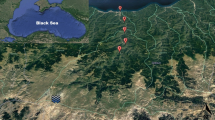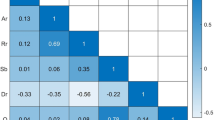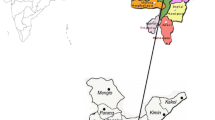Abstract
We have developed a hybrid model that integrates chaos theory and an extreme learning machine with optimal parameters selected using an improved particle swarm optimization (ELM-IPSO) for monthly runoff analysis and prediction. Monthly streamflow data covering a period of 55 years from Daiying hydrological station in the Chaohe River basin in northern China were used for the study. The Lyapunov exponent, the correlation dimension method, and the nonlinear prediction method were used to characterize the streamflow data. With the time series of the reconstructed phase space matrix as input variables, an improved particle swarm optimization was used to improve the performance of the extreme learning machine. Finally, the optimal chaotic ensemble learning model for monthly streamflow prediction was obtained. The accuracy of the predictions of the streamflow series (linear correlation coefficient of about 0.89 and efficiency coefficient of about 0.78) indicate the validity of our approach for predicting streamflow dynamics. The developed method had a higher prediction accuracy compared with an auto-regression method, an artificial neural network, an extreme learning machine with genetic algorithm and with PSO algorithm, suggesting that ELM-IPSO is an efficient method for monthly streamflow prediction.









Similar content being viewed by others
References
Benettin G, Froeschle C, Scheidecker JP (1979) Kolmogorov entropy of a dynamical system with an increasing number of degrees of freedom. Phys Rev A 19:2454–2460
Bordignon S, Lisi F (2000) Nonlinear analysis and prediction of river flow time series. Environmetrics 11:463–477
Bradford PW, Mark SS, Thor HM (1991) Searching for chaotic dynamics in snowmelt runoff. Water Resour Res 27(6):1005–1010
Dhanya CT, Kumar DN (2010) Nonlinear ensemble prediction of chaotic daily rainfall. Adv Water Resour 33:327–347
Duan QY, Sorooshian S, Gupta VK (1992) Effective and efficient global optimization for conceptual rainfall-runoff models. Water Resour Res 28(4):1015–1031
Farmer DJ, Sidorowich JJ (1987) Predicting chaotic time series. Phys Rev Lett 59:845–848
Ghorbani MA, Khatibi R, Mehr AD (2018) Chaos-based multigene genetic programming: a new hybrid strategy for river flow forecasting. J Hydrol 562:455–467
Grassberger P, Procaccia I (1983) Characterization of strange attractors. Phys Rev Lett 50(5):346–349
Han M, Zhang RQ, Xu ML (2017) Multivariate chaotic time series prediction based on ELM–PLSR and hybrid variable selection algorithm. Neural Process Lett 46(2):705–717
Hong M, Wang D, Wang Y, Zeng X, Ge S, Yan H, Singh VP (2016) Mid-and Longterm runoff predictions by an improved phase-space reconstruction model. Environ Res 148:560–573
Hu Z, Zhang C, Luo G, Teng Z, Jia C (2013) Characterizing Crossscale chaotic behaviors of the runoff time series in an Inland River of Central Asia. Quat Int 311(9):132–139
Huang GB, Zhu QY, Siew CK (2006) Extreme learning machine: theory and applications. Neurocomputing 70:489–501
Huang SZ, Chang JX, Huang Q, Chen YT (2014) Monthly streamflow prediction using modified EMD-based support vector machine. J Hydrol 511:764–775
Huang G, Huang GB, Song SJ, You KY (2015) Trends in extreme learning machines: a review. Neural Netw 61:32–48
Islam MN, Sivakumar B (2002) Characterization and prediction of runoff dynamics: a nonlinear dynamical view. Adv Water Resour 25:179–190
Jiang Y, Liu CM, Huang CC, Wu XN (2010) Improved particle swarm algorithm for hydrological parameter optimization. Appl Math Comput 217:3207–3215
Jiang Y, Li XY, Huang CC (2013) Automatic calibration a hydrologicalmodel using a master–slave swarms shuffling evolution algorithm based on self-adaptive particle swarm optimization. Expert Syst Appl 40(2):752–757
Jiang Y, Liu CM, Li XY, Liu LF, Wang HR (2015) Rainfall-runoff modeling, parameter estimation and sensitivity analysis in a semiarid catchment. Environ Model Softw 67:72–88
Kedra M (2013) Deterministic chaotic dynamics of Raba River flow (polish Carpathian Mountains). J Hydrol 509:474–503
Kennel MB, Brown R, Abarbanel HD (1992) Determining embedding dimension for phase space reconstruction using a geometric method. Phys Rev A 45:3403–3411
Khan S, Ganguly AR, Saigal S (2005) Detection and predictive modeling of chaos in finite hydrological time series. Nonlinear Process Geophys 12:41–53
Labat D, Sivakumar B, Mangin A (2016) Evidence for deterministic chaos in long-term high-resolution karstic streamflow time series. Stoch Env Res Risk A 30:2189–2196
Mohammad ZK (2016) Investigating vhaos and nonlinear forecasting in short term and mid-term river discharge. Water Resour Manag 30(5):1851–1865
Ouyang Q, Lu W, Xin X, Zhang Y, Cheng W, Yu T (2016) Monthly rainfall forecasting using EEMD-SVR based on phase-space reconstruction. Water Resour Manag 30(7):2311–2325
Paluš M, Pecen L, Pivka D (1995) Estimating predictability: redundancy and surrogate data method. Neural Network World 4:537–550
Peng T, Zhou JZ, Zhang C, Fu WL (2017) Streamflow forecasting using empirical wavelet transform and artificial neural networks. Water 9(6):406. https://doi.org/10.3390/w9060406
Porporato A, Ridolfi L (1997) Nonlinear analysis of river flow time sequences. Water Resour Res 33(6):1353–1367
Rosenstein MT, Collins JJ, De Luca CJ (1993) A practical method for calculating largest Lyapunov exponents from small data sets. Physica D 65:117–134
Sano M, Sawada Y (1985) Measurement of the Lyapunov spectrum from a chaotic time series. Phys Rev Lett 55(10):1082–1085
Schreiber T, Schmitz A (1996) Improved surrogate data for nonlinearity tests. Phys Rev Lett 77:635–638
Sivakumar B (2000) Chaos theory in hydrology: important issues and interpretations. J Hydrol 227:1–20
Sivakumar B (2004) Chaos theory in geophysics: past, present and future. Chaos, Solitons Fractals 19:441–462
Sivakumar B, Berndtsson R, Olsson J, Jinno K (2001) Evidence of chaos in the rainfall-runoff process. Hydrol Sci 46(1):131–145
Sugihara G, May R (1990) Nonlinear forecasting as a way of distinguishing chaos from measurement error in time series. Nature 344(6268):734–741
Takens F (1981) Detecting strange attractors in turbulence. Lecture Notes in Mathematics 898:366–381
Taormina R, Chau KK (2015) Data-driven input variable selection for rainfall–runoff modeling using binary-coded particle swarm optimization and extreme learning machines. J Hydrol 529:1617–1632
Vicente-Guillén J, Ayuga-Telléz E, Otero D, Chávez JL, Ayuga F, García AI (2012) Performance of a monthly Streamflow prediction model for Ungauged watersheds in Spain. Water Resour Manag 26:3767–3784
Wang QJ (1997) Using genetic algorithms to optimize model parameters. Environ Model Softw 12:27–34
Wang Y, Zhou JZ, Zhou C, Wang YQ, Qin H, Lu YL (2012) An improved selfadaptive PSO technique for short-term hydrothermal scheduling. Expert Syst Appl 39:2288–2295
Wolf A, Swift J, Swinney HL, Vastano A (1985) Determining Lyapunov exponents from a time serie. Physica D: Nonlinear Phenomena 16(3):285–317
Xu JH, Chen YN, Li WH, Ji MH, Dong S (2009) The complex nonlinear systems with fractal as well as chaotic dynamics of annual runoff processes in the three headwaters of the Tarim River. J Geogr Sci 19:25–35
Zhao X, Chen X, Xu Y, Xi D, Zhang Y, Zheng X (2017) An EMD-based chaotic least squares support vector machine hybrid model for annual runoff forecasting. Water 9(3):153. https://doi.org/10.3390/w9030153
Zhou JZ, Peng T, Zhang C, Sun N (2018) Data pre-analysis and ensemble of various artificial neural networks for monthly Streamflow forecasting. Water 10:628. https://doi.org/10.3390/w10050628
Acknowledgments
This research was supported by the National Key Research and Development Plan (2016YFD0201206).
Author information
Authors and Affiliations
Corresponding author
Ethics declarations
Conflict of Interest
The authors declare that they have no conflict of interest.
Additional information
Publisher’s Note
Springer Nature remains neutral with regard to jurisdictional claims in published maps and institutional affiliations.
Rights and permissions
About this article
Cite this article
Jiang, Y., Bao, X., Hao, S. et al. Monthly Streamflow Forecasting Using ELM-IPSO Based on Phase Space Reconstruction. Water Resour Manage 34, 3515–3531 (2020). https://doi.org/10.1007/s11269-020-02631-3
Received:
Accepted:
Published:
Issue Date:
DOI: https://doi.org/10.1007/s11269-020-02631-3




